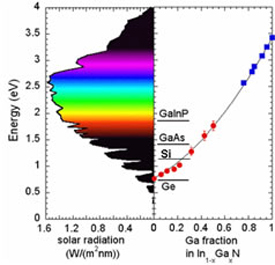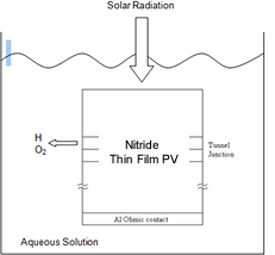
| Home | About Us | Contribute | Bookstore | Advertising | Subscribe for Free NOW! |
| News Archive | Features | Events | Recruitment | Directory |
| FREE subscription |
| Subscribe for free to receive each issue of Semiconductor Today magazine and weekly news brief. |
News
13 October 2009
Nitride solar development
In the past month, RoseStreet Labs Energy (RSLE) has unveiled two developments towards solar power that use nitride semiconductor technology. One development is a nitride semiconductor photovoltaic (PV) device combined with a standard silicon solar cell; the other uses nitride thin-film semiconductors to generate hydrogen electrochemically from sunlight.
 RSLE works with indium gallium nitride (InGaN) combinations. These materials are also used extensively with aluminum to create light emitting and laser diodes covering green to ultraviolet light. By varying the In-Ga proportions the bandgap of the material can be varied from less than 1eV up to around 3eV. These energies cover the greater part of the solar spectrum (Figure 1).
RSLE works with indium gallium nitride (InGaN) combinations. These materials are also used extensively with aluminum to create light emitting and laser diodes covering green to ultraviolet light. By varying the In-Ga proportions the bandgap of the material can be varied from less than 1eV up to around 3eV. These energies cover the greater part of the solar spectrum (Figure 1).
Semiconductor materials are relatively transparent to photon energies below their band gap energy. By combining layers of semiconductor materials in tandem, one can arrange to extract energy from light more efficiently, gathering the high energy photons first and then lower down the less energetic light, which is not absorbed by the wider gap material above.
The standard silicon PV technology is based on that material’s bandgap energy of ~1eV. One can use silicon to extract energy from photons above this energy; however, much of the energy is then lost with each photo-generated electron only delivering the useful energy of the bandgap with the rest of the photon’s energy being lost as heat.
Ultimately, RSLE is aiming at 25-30% efficiencies. Commercial PV cells deliver in the 10-20% range (although ~22% is claimed on behalf Sunpower’s crystalline silicon solar cell), depending on cost and technology. Production devices based on RSLE’s technology is expected around fourth quarter 2010.
Bob Forcier, CEO of RSLE, said: “We are quite excited about this new hybrid solar cell that marries low cost nitride thin film with the massive infrastructure of silicon solar cells. Our target market for this hybrid device is the high performance sector for photovoltaics which we estimate to be over 1% of the $34 billion solar cell global market. This high performance market is especially sensitive to applications which have constrained areas such as industrial rooftops and mobile devices.”
 The photo-electrochemical cell (Figure 2) immerses a nitride-thin-film PV device in an aqueous solution with the potential to generate hydrogen with about 10% efficiency. This depends on the control of the bandgap energy allowed by using the III-nitride semiconductor system.
The photo-electrochemical cell (Figure 2) immerses a nitride-thin-film PV device in an aqueous solution with the potential to generate hydrogen with about 10% efficiency. This depends on the control of the bandgap energy allowed by using the III-nitride semiconductor system.
See related item:
RoseStreet opens full-spectrum solar cell development center
![]() Search: Solar cell Photovoltaic CPV InGaN
Search: Solar cell Photovoltaic CPV InGaN
Visit: www.rosestreetlabs.com